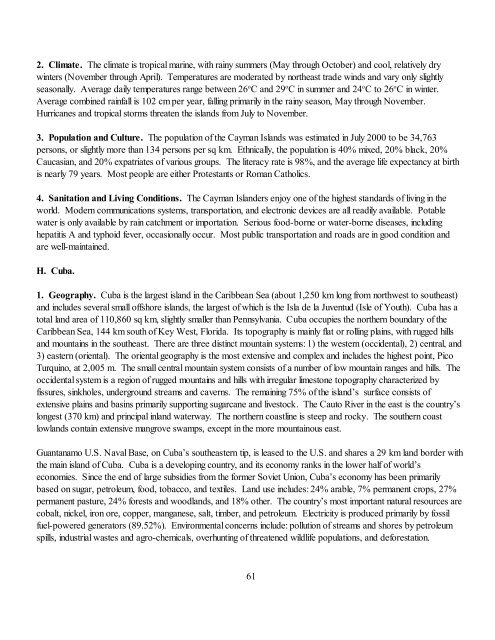Caribbean - Armed Forces Pest Management Board
Caribbean - Armed Forces Pest Management Board
Caribbean - Armed Forces Pest Management Board
Create successful ePaper yourself
Turn your PDF publications into a flip-book with our unique Google optimized e-Paper software.
2. Climate. The climate is tropical marine, with rainy summers (May through October) and cool, relatively dry<br />
winters (November through April). Temperatures are moderated by northeast trade winds and vary only slightly<br />
seasonally. Average daily temperatures range between 26 o C and 29 o C in summer and 24 o C to 26 o C in winter.<br />
Average combined rainfall is 102 cm per year, falling primarily in the rainy season, May through November.<br />
Hurricanes and tropical storms threaten the islands from July to November.<br />
3. Population and Culture. The population of the Cayman Islands was estimated in July 2000 to be 34,763<br />
persons, or slightly more than 134 persons per sq km. Ethnically, the population is 40% mixed, 20% black, 20%<br />
Caucasian, and 20% expatriates of various groups. The literacy rate is 98%, and the average life expectancy at birth<br />
is nearly 79 years. Most people are either Protestants or Roman Catholics.<br />
4. Sanitation and Living Conditions. The Cayman Islanders enjoy one of the highest standards of living in the<br />
world. Modern communications systems, transportation, and electronic devices are all readily available. Potable<br />
water is only available by rain catchment or importation. Serious food-borne or water-borne diseases, including<br />
hepatitis A and typhoid fever, occasionally occur. Most public transportation and roads are in good condition and<br />
are well-maintained.<br />
H. Cuba.<br />
1. Geography. Cuba is the largest island in the <strong>Caribbean</strong> Sea (about 1,250 km long from northwest to southeast)<br />
and includes several small offshore islands, the largest of which is the Isla de la Juventud (Isle of Youth). Cuba has a<br />
total land area of 110,860 sq km, slightly smaller than Pennsylvania. Cuba occupies the northern boundary of the<br />
<strong>Caribbean</strong> Sea, 144 km south of Key West, Florida. Its topography is mainly flat or rolling plains, with rugged hills<br />
and mountains in the southeast. There are three distinct mountain systems: 1) the western (occidental), 2) central, and<br />
3) eastern (oriental). The oriental geography is the most extensive and complex and includes the highest point, Pico<br />
Turquino, at 2,005 m. The small central mountain system consists of a number of low mountain ranges and hills. The<br />
occidental system is a region of rugged mountains and hills with irregular limestone topography characterized by<br />
fissures, sinkholes, underground streams and caverns. The remaining 75% of the island’s surface consists of<br />
extensive plains and basins primarily supporting sugarcane and livestock. The Cauto River in the east is the country’s<br />
longest (370 km) and principal inland waterway. The northern coastline is steep and rocky. The southern coast<br />
lowlands contain extensive mangrove swamps, except in the more mountainous east.<br />
Guantanamo U.S. Naval Base, on Cuba’s southeastern tip, is leased to the U.S. and shares a 29 km land border with<br />
the main island of Cuba. Cuba is a developing country, and its economy ranks in the lower half of world’s<br />
economies. Since the end of large subsidies from the former Soviet Union, Cuba’s economy has been primarily<br />
based on sugar, petroleum, food, tobacco, and textiles. Land use includes: 24% arable, 7% permanent crops, 27%<br />
permanent pasture, 24% forests and woodlands, and 18% other. The country’s most important natural resources are<br />
cobalt, nickel, iron ore, copper, manganese, salt, timber, and petroleum. Electricity is produced primarily by fossil<br />
fuel-powered generators (89.52%). Environmental concerns include: pollution of streams and shores by petroleum<br />
spills, industrial wastes and agro-chemicals, overhunting of threatened wildlife populations, and deforestation.<br />
61

















